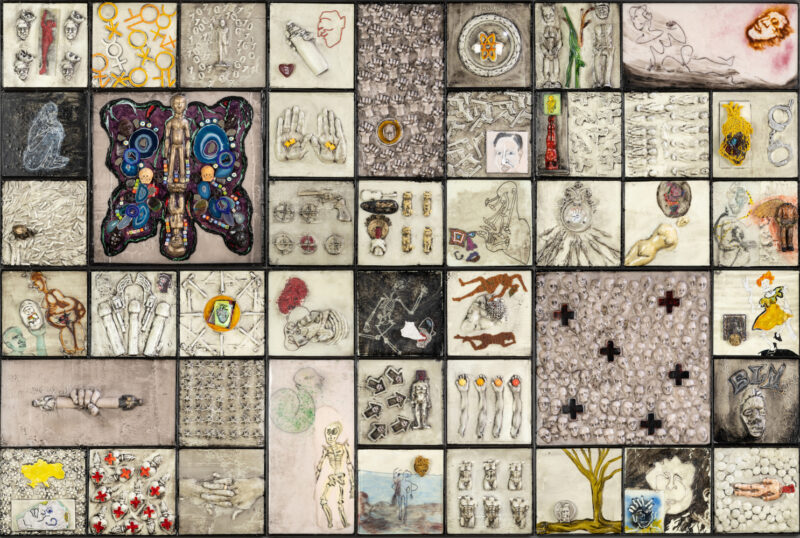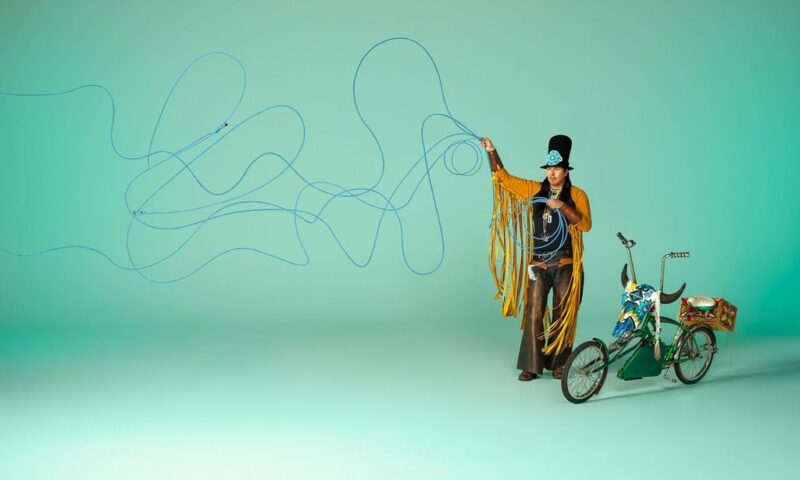 Kriston Capps and Cara Ober discuss the exhibit at the BMA, the jurors, the artists, and the outcome.
Kriston Capps and Cara Ober discuss the exhibit at the BMA, the jurors, the artists, and the outcome.
KC: Who did you think would win and why did you think that?
CO: Every year I am stymied by the Sondheim winner, so this year I decided to do a reader’s poll on Bmore Art, asking who did readers think would win. Notice, this is quite different than asking who deserved to win. For a couple of weeks, people solidly believed Karen Yasinsky would take it, so I did, too. After the show was up and photos of the exhibit were posted, I changed my mind. I thought that Ryan Hackett was a shoe-in. The room he occupied felt elegantly curated, thematic in a way that made each piece more interesting, and tactile in an intellectual, scientific, and sensory way. Hackett handled concerns of space and color with finesse and walked a fine line between sterile and warm/fuzzy in a way that I had never experienced before. Hackett’s ‘room’ could be equally enjoyed by an art theorist and a five-year-old, challenging yet accessible.
I thought that all the artists put together interesting exhibits, but felt most strongly about Hackett’s work after viewing them all. Judging from the six finalists, I thought that the jurors seem to favor intellectual precision, an integration with technology, a contemporary narrative, and an unemotional editing process. Five out of the six finalists embodied these terms – everyone except the BDC.
From the beginning I thought the BDC was the black sheep of the group; their content and their craftsmanship appeared to be completely different. They seemed to be the anomaly, rather than the front-runner.
How about you, Kriston? Were you surprised by the outcome of the prize? Who were you betting on? And what, in your opinion, should a jury consider when choosing the winner of the Sondheim Prize?
KC: I get sucked in by the Kremlinology involved in trying to guess what the judges will like. This year I thought there were a lot of clues. Knowing Ellen Harvey’s work and the shows that Elisabeth Sussman made and would have seen and so on, I guessed that Karen Yasinsky would be out because they would have seen a lot of work by Nathalie Djurberg over the last year: a solo show at Zach Feuer, stuff at the Biennale, stuff at the New Museum. Djurberg’s work was in “The Puppet Show,” which traveled to the Contemporary Arts Museum Houston this year, so undoubtedly Valerie Cassel Oliver was familiar with it. Yasinksy’s video piece strikes me as very familiar but not as advanced as Djurgberg’s.
I felt the same way about the Baltimore Development Cooperative: The work looked too much like what I’d seen (and what I was sure the jurors would have seen) at the last WhiBi and the big NuMu Unmonumental exhibit. Of course, when I first toured the exhibit I was just considering the work on display, and not the careerwide practice that in all likelihood earned them the top nod.
It’s not wrong to consider the broader art-world context when doling out the award—that’s presumably why the Sondheim folks bring in outside, established art-world figures to serve as jurors. At the same time, I think that limits the extent to which the jury can determine the work’s effect within the community, such as you might need to judge with the BDC’s work if you’re not just looking at the physical artifact. Is the group’s community garden area (Participation Park) as integrated within the east Baltimore community where it’s located as the artists say? I know that only a couple groups have signed up to use the geodesic tent (The Pavilion) outside the museum.
For their work, evaluating their success on their own terms seems really crucial to determining whether it’s good work. The impression I got is that they have yet to really realize these utopian projects. And if that’s the case—if they aren’t socially integrated activist projects—aren’t they just lo-fi, cardboard sculptures with high aspirations?
So, sure, I was disappointed with that decision. I have a hard time squaring the fact that the jurors used this criterion for the BDC’s work that they didn’t or couldn’t apply to the other artists in the show. And it’s a criterion by which the BDC arguably fall short. But maybe you can elaborate on that: What is their effect within the community? What sort of research is involved in their practice? I got no sense of that from the work, from their site, etc.
CO: I am not sure about the effect of the BDC within the community. In certain art-based social circles, the three members who won the prize – Scott Berzofsky, Dane Nester, and Nicholas Wisniewski – are well-respected names, but before the prize was given, I could find nothing documented online about the group – no website, no publications, nothing. In terms of research, if you read the literature provided by the museum, the BDC “uses the strategies of art, research, and activism to critically engage with urban spatial politics.” This sounds admirable, but what does it mean? I asked a random sampling of people about the geodesic dome in front of the BMA and very few people seemed to understand its purpose or intended political statement. Only a very elite group of artists seemed to ‘get’ the dome’s egalitarian purpose, which, to me, seems like unclear communication.
I think this group has good intentions and good ideas, but there is an element of rigor that is missing – both visually and in content. When I think about art historical examples of activist art, Mierle Laderman Ukeles comes to mind. She did a project with the NY city sanitation department, set up a desk there, conducted research, and then did a series of performances to educate the public and to contradict commonly held assumptions about sanitation workers and garbage men. Her work was conducted with a pointed humor, and was precise – in terms of message and media. In contrast, the BDC’s work at the BMA seems incoherent and vague.
Looking back, it seems that every year the winner of the Sondheim Prize is chosen based on community activism or contributions beyond the body of work displayed in the museum. Laure Drogoul, the first Sondheim winner has been a tireless volunteer and participant in Baltimore community art projects. Tony Shore, the second Sondheim winner, is the founder of Access Art, a youth art center in Baltimore’s Morrell Park Neighborhood. The third Sondheim winner, Geoff Grace is a public high school teacher who integrated some of his students work into his installation. If we look at the three previous winners, the obvious connection is not media or content – it is community involvement and service.
While this civic activity is noble and beneficial to Baltimore, especially, I fail to see why this should be considered as criteria for naming a top visual artist. When you look at Sondheim Prize literature, there’s nothing explicit about community involvement. In theory, the Sondheim Prize is supposed to be given to the best artist, the best body of work. Do you think this element of community activism is an invention of my imagination or there is a connection between an artist’s politics and the outcome of an art award? If so, what does it say about the credibility and mission of this award?



